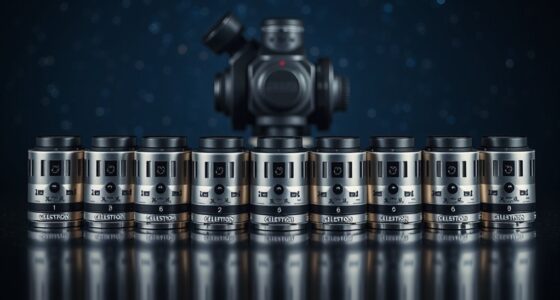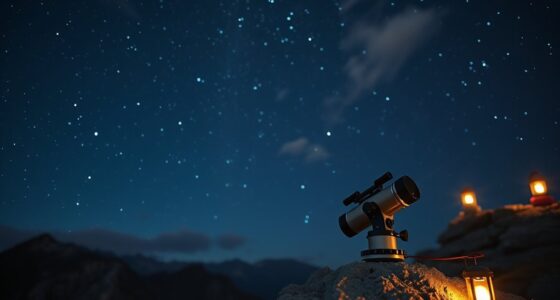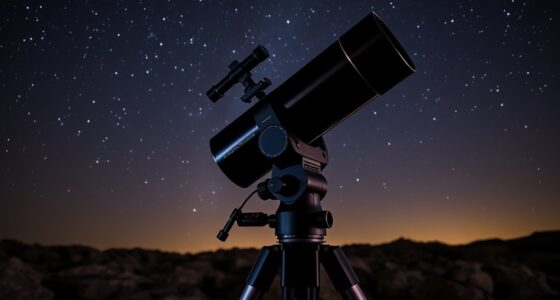If you’re looking for the best carbon fiber dew heaters, I recommend checking options that fit your lens or telescope size, like USB heaters or strips rated for lenses up to 80mm or 127mm in diameter. Look for models with adjustable temperature control, quick heating, and easy installation, so you can keep your gear fog-free during outdoor shoots. Keep in mind power sources and compatibility—if you want more detailed insights, there’s plenty to explore ahead.
Key Takeaways
- These dew heaters are designed to prevent fogging on lenses and telescopes using efficient carbon fiber heating elements.
- They come in various sizes and compatibility options for different equipment, from small camera lenses to large telescopes.
- Many models feature adjustable heat settings and USB or 12V power options for versatile outdoor use.
- Easy installation with flexible wraps, straps, or integrated shields ensures quick setup and removal.
- They offer reliable, even heating to maintain clear, frost-free gear during outdoor astrophotography or observation.
JJC USB Lens Warmer for 80mm Lenses
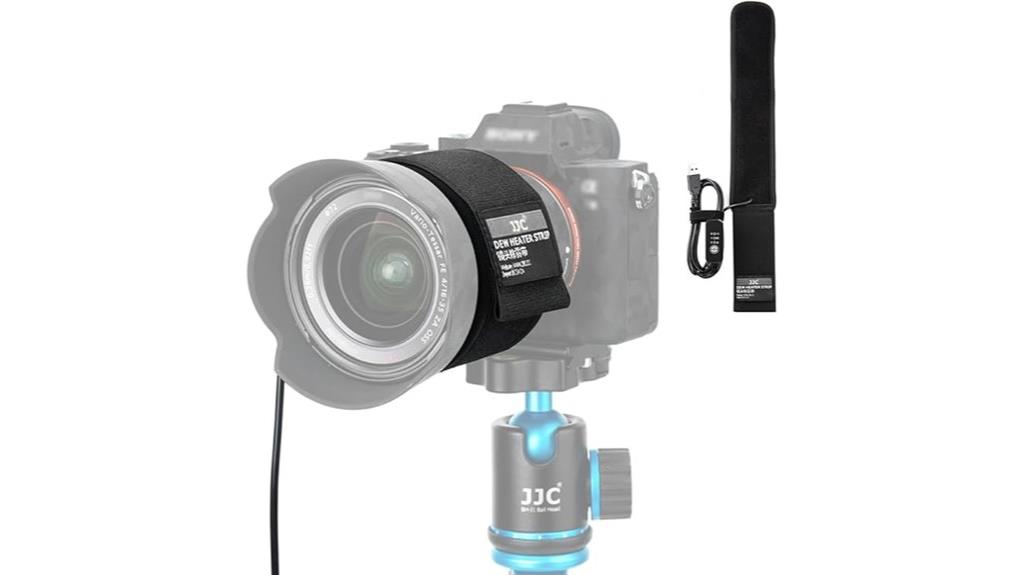
If you’re looking for a reliable solution to prevent condensation on your 80mm lenses, the JJC USB Lens Warmer is an excellent choice, especially for astrophotographers and outdoor shooters. It’s designed for lenses with a diameter less than 80mm, making it versatile for telescopes, viewfinders, and digital camera lenses. Made from high-quality materials, it provides fast heat transfer and good insulation. The neoprene strap with velcro allows quick attachment and removal. With adjustable temperature settings up to about 33°C, it effectively prevents fogging in cold or humid conditions. Powered via USB, it’s perfect for outdoor use, giving you clarity during chilly early mornings or winter shoots.
Best For: outdoor astrophotographers and photographers using 80mm or smaller lenses who need effective condensation prevention in cold or humid conditions.
Pros:
- Easy to attach and remove with neoprene strap and velcro, ensuring quick setup.
- Adjustable temperature settings up to approximately 33°C to prevent fogging without overheating.
- Powered via USB, compatible with power banks and USB chargers, suitable for outdoor use.
Cons:
- Requires external power sources, which may be inconvenient during extended outdoor shoots.
- Limited to lenses with a diameter under 80mm, restricting use with larger lenses.
- Some users find managing long USB cords cumbersome in certain shooting environments.
Astromania USB Lens Heater Warmer Dew Heater Strip (30cm)

The Astromania USB Lens Heater Warmer Dew Heater Strip (30cm) stands out as an ideal choice for photographers and astronomers who need a portable, precise solution to prevent lens fogging in humid or cold conditions. Its flexible design easily conforms around lenses less than 80mm in diameter, secured with strong Velcro. The stepless temperature control allows me to adjust heat levels smoothly, while the USB connection makes it convenient to power from portable banks. Heats lenses about 11-14°F above ambient, effectively preventing fog during outdoor shoots. Lightweight and straightforward to use, it’s a reliable tool for keeping gear frost-free without adding bulk.
Best For: photographers and astronomers seeking a portable, adjustable lens dew heater to prevent fogging in cold or humid outdoor conditions.
Pros:
- Flexible, conformable design with strong Velcro for easy attachment around lenses less than 80mm in diameter.
- Stepless temperature control via sliding knob allows precise heat adjustment.
- USB-powered for convenient use with portable power banks, enhancing mobility.
Cons:
- Heats lenses only 11-14°F above ambient, which may be insufficient in extremely cold environments.
- Less conforming and stiffer than some other heater strips, potentially affecting fit.
- No included instructions, so initial setup may require some trial and error.
Premier 1 Carbon Fiber Heater for Poultry and Livestock
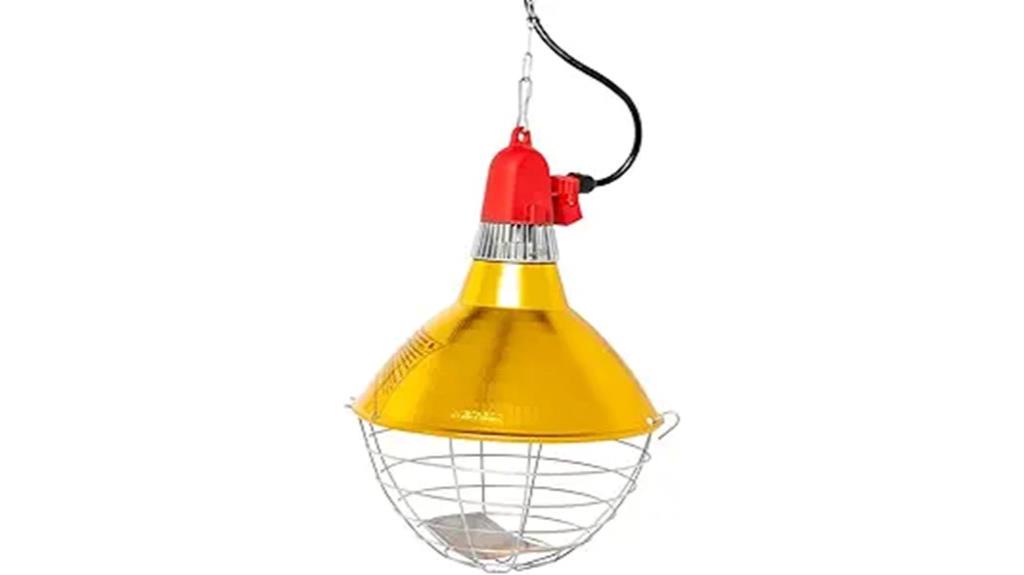
Premier 1 Carbon Fiber Heater stands out as an excellent choice for poultry and livestock owners seeking a safe, energy-efficient heating solution. Its built-in safety kill switch automatically turns off the unit if it tilts more than 30°, preventing accidents. The wire grill keeps animals safe from contact, while cooling fins reduce heat build-up around controls for added durability. With high-output carbon fiber bulbs, it produces 4-6 times more heat than traditional options, converting 98% of wattage into warmth. Easy to operate with a simple on/off switch, it includes a 7.5 ft cord and a secure hanging attachment, ensuring reliable, safe heating for your animals.
Best For: poultry and livestock owners seeking a safe, energy-efficient, and easy-to-install heating solution to maintain optimal warmth in their animals’ environment.
Pros:
- Equipped with a safety kill switch and wire grill for enhanced safety during operation
- High-output carbon fiber bulbs deliver 4-6 times more heat with 98% wattage conversion efficiency
- Simple to operate with a convenient on/off switch, 7.5 ft cord, and secure hanging attachment
Cons:
- Some assembly required before installation
- Not suitable for chick brooders due to design considerations
- Installation requires placement at least 5 ft above animals and away from walls or objects
SVBONY SV192 Dew Heater Strip for Telescope and DSLR Lens
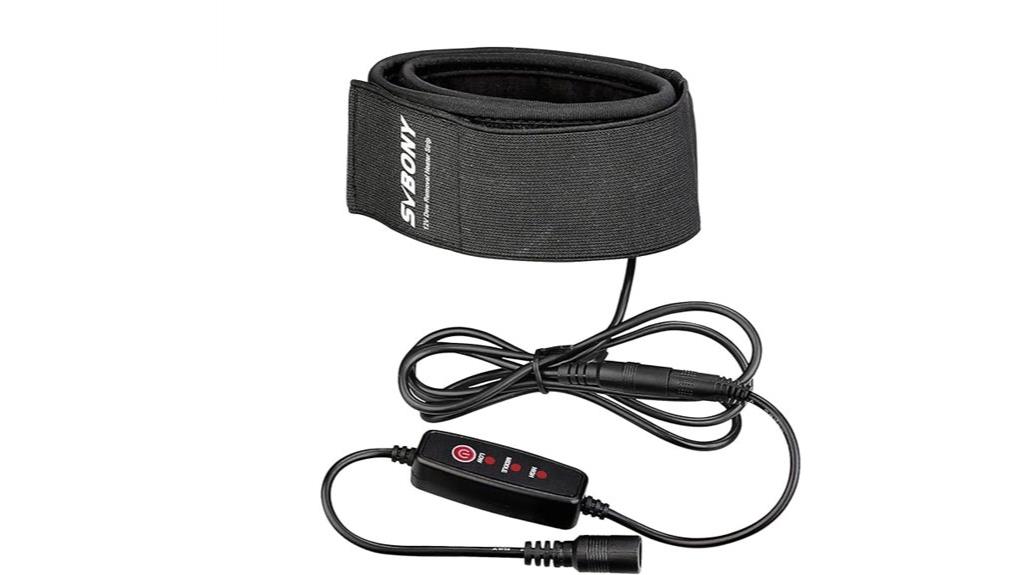
For astronomers and photographers seeking an effective dew prevention solution, the SVBONY SV192 Dew Heater Strip stands out due to its precise compatibility and focused design. Measuring 560mm, it’s ideal for large camera lenses and telescopes with outer diameters below 178mm. Its narrow 50mm width helps avoid focusing issues and dark corners, ensuring minimal obstruction. Made with aluminum for even heating and alloy fiber wiring for rapid warmth, it offers fast, uniform performance. Powered by 12V DC with adjustable LED-controlled levels, it’s flexible, sturdy, and easy to install using velcro or elastic bands. Many users praise its reliability, affordability, and compatibility with accessories like ASIAir.
Best For: Amateur and professional astronomers or astrophotographers seeking an efficient, focused dew prevention solution for large lenses and telescopes.
Pros:
- Even heat distribution with aluminum construction for reliable dew prevention
- Narrow 50mm width minimizes obstruction and focusing issues
- Easy to install and adjust with velcro, elastic bands, and LED-controlled temperature levels
Cons:
- No USB connectivity for integrated control via USB hubs or controllers
- Limited compatibility to lenses and scopes with diameters below 178mm
- Requires 12V DC power, which may necessitate additional power adapters or sources
Dew Heater Strip – 6.5 Length # DN02
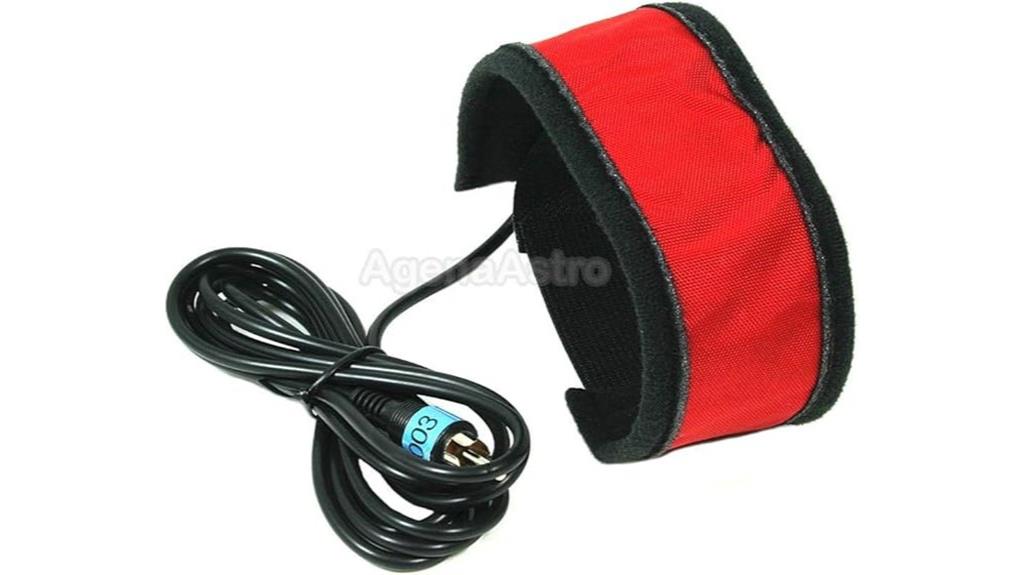
If you’re looking for a compact and reliable dew heater strip, the Dew Heater Strip – 6.5 Length # DN02 is an excellent choice. Made in the USA by Dew-Not, it features a thick film design that guarantees even heat distribution, preventing hot spots or burnouts. It’s perfect for smaller optical devices like guide scopes and eyepieces, with a length that fits snugly around your equipment. The strip feels barely warm during operation, offering effective dew prevention while saving power. Compatible with 12V power supplies and dew controllers, it’s easy to set up and highly durable. Many users appreciate its reliability, low cost, and long lifespan.
Best For: astronomers and astrophotographers seeking a compact, reliable dew heater strip for small optical devices like guide scopes and eyepieces.
Pros:
- Provides even heat distribution to prevent hot spots and burnouts
- Easy to install and operate with standard 12V power supplies and dew controllers
- Durable construction with a long lifespan and minimal heat feel during use
Cons:
- Limited to devices with a circumference suitable for the 6.5-inch length
- Requires separate 12V power supply with RCA connector, not directly powered from AC or USB
- Not suitable for larger telescopes or equipment requiring longer heating strips
SVBONY SV172 Lens Warmer, 400mm Heater Dew Strip for Telescope Camera

The SVBONY SV172 Lens Warmer stands out as an excellent choice for astronomers and astrophotographers who need a reliable, portable solution to prevent dew buildup on their telescope cameras. Its 400mm heating strip is compatible with lenses up to 127mm in diameter and features a design that doesn’t interfere with focusing or field of view. Made with aluminum for even heat distribution and alloy fiber wiring for rapid warming, it offers three adjustable temperature settings for precise control. Powered via USB, it’s lightweight and easy to carry, making it perfect for outdoor sessions. Plus, its versatility allows it to warm water bottles or serve as a knee strap, enhancing its usefulness.
Best For: astronomers and astrophotographers seeking a portable, reliable solution to prevent dew buildup on telescope camera lenses during outdoor observations.
Pros:
- Compatible with lenses up to 127mm in diameter, ensuring broad applicability.
- Adjustable three-gear temperature regulation for precise control.
- Compact, lightweight design with USB power for easy portability and outdoor use.
Cons:
- Limited to lenses with outer diameters below 127mm, not suitable for larger lenses.
- Requires a USB power source with sufficient current (1.9A-2.0A at 5V), which may limit compatibility with some power banks.
- Only a 50mm bandwidth, which might not cover extremely wide lenses or specific needs requiring broader coverage.
USB Lens Warmer with Temperature Regulator for Telescope and DSLR Lens Less Than 3.15 inch (80mm)
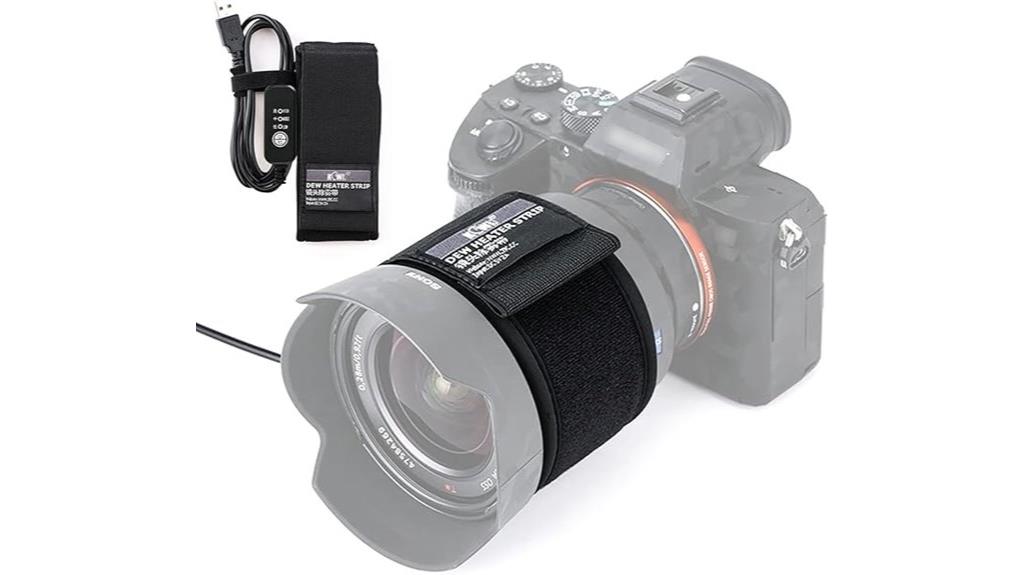
When capturing clear images in cold environments, maintaining lens temperature is essential, and this USB Lens Warmer with Temperature Regulator excels at that task. It’s designed for telescopes, viewfinder lenses, and DSLR lenses up to 80mm in diameter, ensuring they stay fog-free and perform *best*. The adjustable temperature control with low, medium, and high modes allows precise regulation, even in temperatures as low as -40°C. Powered via USB, it’s compatible with power banks for long outdoor sessions. Made from high-quality materials, it heats quickly and prevents condensation, keeping your gear clear and safe during your photography or astronomy adventures.
Best For: photographers, astronomers, and outdoor enthusiasts who need to prevent lens fogging and maintain optimal equipment performance in cold environments.
Pros:
- Adjustable temperature regulation with low, medium, and high modes for precise control
- Compatible with USB power sources like power banks for long outdoor use
- High-quality materials provide fast heat transfer and effective thermal insulation
Cons:
- Suitable only for lenses with diameters less than 80mm (3.15 inches)
- May be shipped with either the new or old controller version, which could affect aesthetics but not functionality
- Requires USB power source, which may not be included with the warmer
NEEWER USB Lens Heater for DSLR Camera and Telescope

Looking to keep your camera lenses and telescopes clear during outdoor astrophotography or cold-weather shoots? The NEEWER USB Lens Heater is a compact, effective solution. Designed for lenses up to 10.8 inches circumference, it wraps around your gear to prevent dew, fog, and condensation. Powered via USB 5V, it offers three adjustable heat settings, maintaining consistent warmth even in freezing temperatures. Its lightweight, elastic fastener makes installation easy, and it works well with portable power banks for overnight use. Perfect for astrophotography, star trails, or outdoor night shooting, it ensures clear images without the hassle of moisture. Just remember, it’s meant for dew prevention, not other uses.
Best For: outdoor astrophotographers, star trail enthusiasts, and anyone needing to prevent dew or condensation on camera lenses or telescopes in cold weather.
Pros:
- Effective dew and fog prevention on lenses up to 10.8 inches circumference, ensuring clear imaging in outdoor conditions.
- Easy to install with lightweight, elastic fastener and adjustable heat settings for customized warmth.
- Compatible with various USB power sources like portable chargers and power banks, suitable for extended outdoor use.
Cons:
- Does not retain previous heat setting after power interruption, requiring re-adjustment each time it is powered on.
- Limited to dew prevention; not designed for other unconventional uses or heating needs.
- Actual voltage around 4.7V may result in slightly lower maximum temperature compared to nominal specifications.
R-Sky Dew Heater with Integrated Shield

For amateur astronomers seeking a reliable anti-dew solution, the R-Sky Dew Heater with Integrated Shield stands out thanks to its built-in dew shield and heater combo. Designed specifically for reflex sight finders, it effectively prevents fogging and frost on the finder window, ensuring clear visibility. Powered by a 12V RCA connection, it offers flexible, tangle-free cable management and easy installation with an elastic strap and silicone grip. The system works seamlessly together to keep your finders dew-free, providing uninterrupted observation. It’s compatible with most reflex sights, making it a versatile, low-maintenance choice for anyone looking to protect their gear from outdoor dew buildup.
Best For: amateur astronomers seeking an effective, easy-to-install anti-dew solution for reflex sight finders during outdoor observations.
Pros:
- Combines dew shield and heater in a single, integrated unit for convenience
- Powered by a standard 12V RCA connection for flexible cable management
- Easy to install securely with elastic strap and silicone grip, no tools required
Cons:
- Compatibility may vary with some reflex sight models
- Requires a 12V power source, which may not be available in all setups
- May need regular monitoring to ensure consistent operation in extreme weather conditions
250mm DC Lens Heater for Telescopes and Cameras
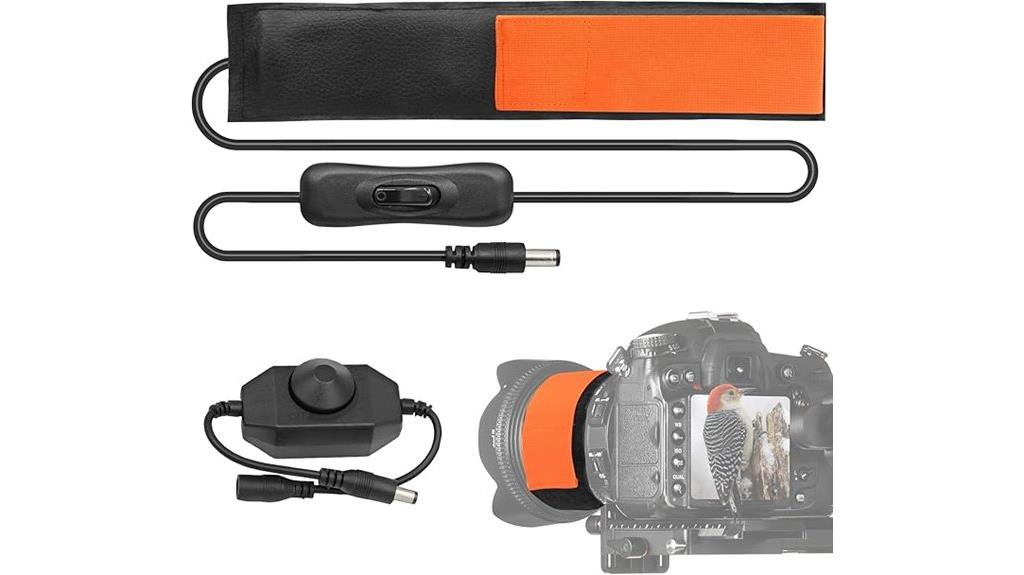
The 250mm DC Lens Heater is an ideal choice for astronomers and photographers who need reliable fog prevention for their telescopes and camera lenses. It fits lenses and devices with an outer diameter under 80mm, offering adjustable sizing for versatile use. Designed to prevent fogging, dew formation, and freezing, it keeps your optics clear in cold or damp conditions, ensuring maximum performance at night. With stepless temperature control, you can easily set the perfect warmth. Powered via a DC port, it’s compatible with power banks or other portable sources, making it convenient for on-the-go use. This heater strip is perfect for DSLR lenses, telescope eyepieces, and similar devices.
Best For: amateur astronomers and outdoor photographers seeking reliable fog prevention for their telescopes and camera lenses in cold or damp conditions.
Pros:
- Adjustable to fit lenses and devices under 80mm in diameter, offering versatile compatibility
- Stepless temperature control allows precise warmth regulation for optimal fog prevention
- Portable and easy to use with a DC power port compatible with power banks for on-the-go operation
Cons:
- Limited to devices with an outer diameter less than 80mm, not suitable for larger lenses
- Requires a compatible power source, which may not be readily available in all environments
- May need careful handling to ensure proper attachment and avoid overheating
Astromania 25cm DC Lens Heater Warmer Dew Heater Strip
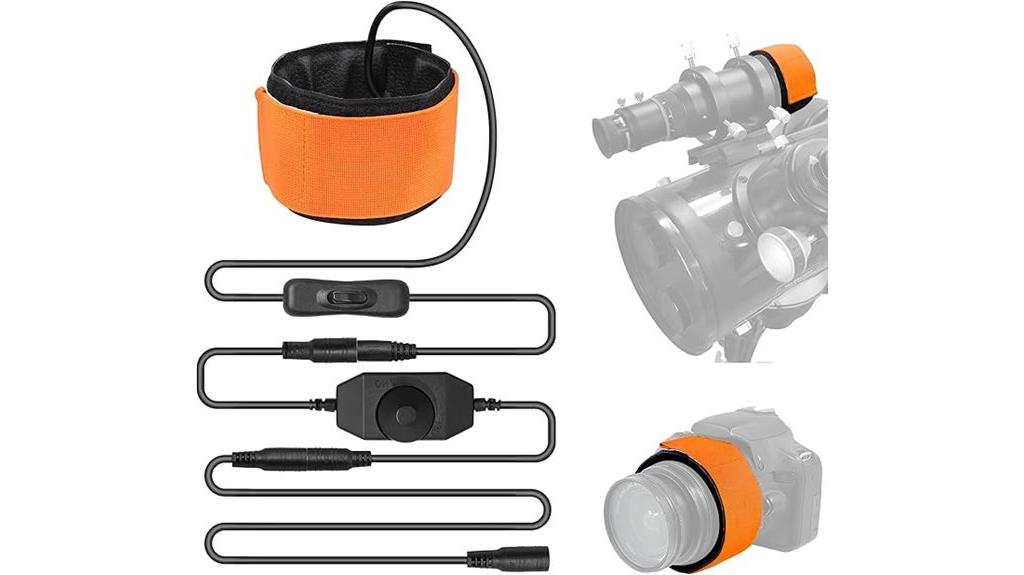
If you need a reliable solution to prevent fogging and dew on your lenses, the Astromania 25cm DC Lens Heater Warmer Dew Heater Strip offers precise temperature control and versatile compatibility. Designed for lenses under 80mm in diameter, it’s easy to install and remove, fitting a range of telescopes and cameras. With stepless temperature regulation via a sliding knob, you can adjust the heat exactly as needed. Powered through a standard DC port, it connects easily to power banks or other sources. Weighing just over 3 ounces, it’s lightweight and portable, ensuring your gear stays clear during cold, damp conditions.
Best For: astrophotographers, astronomers, and outdoor observers who need to prevent fogging and dew on lenses during cold or damp conditions.
Pros:
- Precise stepless temperature regulation for optimal control
- Compatible with lenses under 80mm in diameter and easy to install or remove
- Powered via standard DC port, compatible with power banks and portable sources
Cons:
- Relatively lightweight, which may affect durability in rough handling
- Customer ratings are moderate at 3.5 out of 5 stars, indicating mixed reviews
- Limited to lenses less than 80mm, not suitable for larger or specialized equipment
Lens Warmer, LOSHARP Dew Heater for Telescope Lens Heating and Dehumidification

When selecting a dew heater for telescope lenses, the LOSHARP Dew Heater stands out thanks to its intelligent temperature regulation and versatile compatibility. I appreciate its quick start-up, taking just five seconds to begin warming, and its adjustable modes—strong, medium, and weak—allow me to customize the heat as needed. It’s USB-powered, so I can connect it to a power bank or any USB port, making it portable and easy to use in the field. Its adjustable diameter and reliable adherence fit most telescopes, finder scopes, and cameras. Overall, it’s a practical, efficient solution for preventing fogging, freezing, and dew during my outdoor observing sessions.
Best For: amateur astronomers and outdoor observers seeking an easy-to-use, portable dew prevention solution for telescope lenses, finder scopes, and digital cameras.
Pros:
- Rapid start-up within 5 seconds, providing quick warming.
- Adjustable heating modes (strong, medium, weak) for customized temperature control.
- USB-powered for versatile and portable use with power banks or USB ports.
Cons:
- May require careful adjustment to prevent overheating in sensitive equipment.
- Compatibility depends on proper adherence and adjustable diameter, which might need fine-tuning.
- Limited to USB power sources, which may not be ideal in all outdoor scenarios.
COOWOO Lens Heater Warmer Dew Heater Strip with Temperature Regulator

For photographers and astronomers facing cold, humid conditions, the COOWOO Lens Heater Warmer Dew Heater Strip stands out as a reliable solution. Made from durable neoprene, it’s flexible and safe, certified by CE and RoHs. Its 80cm adjustable temperature regulator features low, medium, and high settings, letting me customize heat to prevent fogging. It’s USB-powered, so I can connect it to power banks easily. Besides lens heating, I’ve used it to warm water bottles and as a cold-weather accessory like a wrist strap. Its compact design makes it perfect for outdoor use, ensuring my gear stays frost-free during night shoots or morning sessions.
Best For: photographers and astronomers who need to prevent lens fogging and protect their equipment in cold, humid outdoor conditions.
Pros:
- Made from durable, flexible neoprene material that is CE and RoHs certified for safety.
- Features an 80cm adjustable temperature regulator with low, medium, and high settings for customizable heating.
- USB-powered, making it easy to connect to power banks for portable outdoor use.
Cons:
- May require a power bank or USB source, which could be an additional accessory to carry.
- Limited to temperature regulation and may not fully prevent fogging in extremely humid environments without proper insulation.
- Designed primarily for lenses and small items; larger gear or different applications may not be compatible.
JJC USB Lens Warmer for Telescopes and Mirrorless Cameras
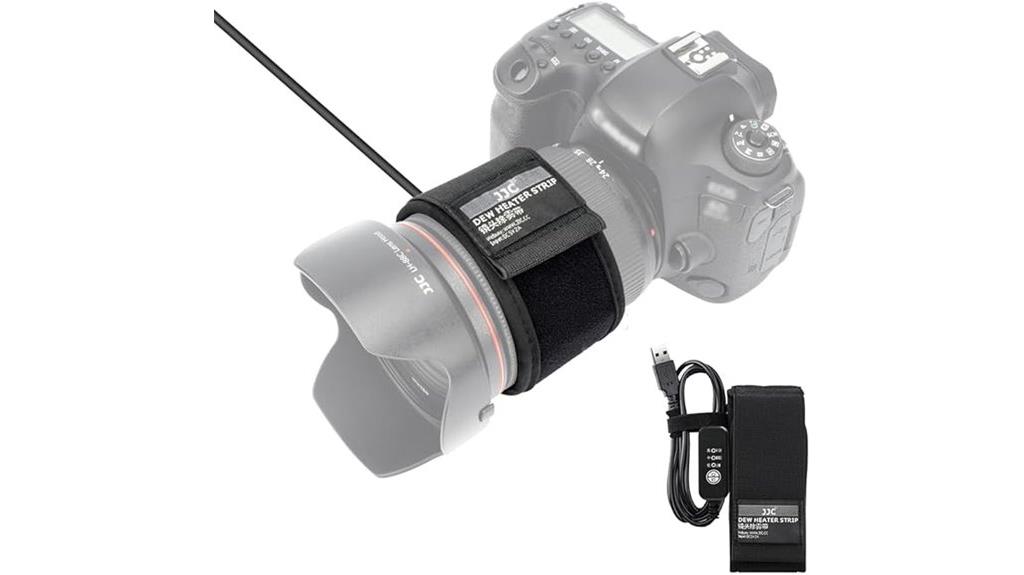
The JJC USB Lens Warmer is an essential tool for astrophotographers and outdoor enthusiasts who need reliable condensation prevention for their telescopes and camera lenses. It fits lenses from 80mm to 110mm in diameter and is versatile enough for telescopes, digital cameras, thermos, or even baby bottles. Made from high-quality materials, it heats quickly and offers excellent thermal insulation. The adjustable temperature regulator with low, medium, and high modes ensures ideal performance in cold environments, even down to -40°C. Powered via USB, it’s easy to connect to power banks, making it perfect for long outdoor sessions and easy to install or remove.
Best For: outdoor astrophotographers and telescope users seeking reliable condensation prevention and temperature control for lenses and equipment in cold environments.
Pros:
- Rapid heating with high-quality insulation materials for effective condensation prevention.
- Adjustable temperature modes suitable for temperatures as low as -40°C, ensuring versatility in harsh climates.
- USB-powered design allows easy connection to power banks, ideal for long outdoor sessions and portability.
Cons:
- Limited to lens diameters between 80mm and 110mm, may not fit larger or smaller lenses.
- Requires a USB power source, which may necessitate additional accessories for some users.
- Installation and removal depend on manual adjustment, which might be less convenient during quick setup scenarios.
USB Lens Heater with Adjustable Dew Prevention for Cameras and Telescopes

If you’re serious about capturing clear images in cold or humid conditions, the USB Lens Heater with adjustable dew prevention is an essential tool. It prevents fog, dew, condensation, and freezing, ensuring your camera or telescope stays operational in adverse weather. With three adjustable temperature settings—high, medium, and low—you can customize the heat level for ideal performance. Its compact design and universal fit make attachment quick and easy, securing the heater firmly to various lenses. Powered via USB, it works with portable power supplies, allowing continuous use outdoors. This reliable device keeps your gear frost-free, so you never miss a shot due to weather-related issues.
Best For: photographers, astronomers, and outdoor videographers who need to prevent lens fog, dew, or freezing during cold or humid conditions.
Pros:
- Adjustable temperature settings for customized dew prevention
- Compact and lightweight design for easy portability and quick attachment
- Compatible with various lenses and power sources via USB
Cons:
- May require external power bank for prolonged outdoor use
- Limited to USB power sources, which might not be convenient in all situations
- The review count is currently low, so long-term user feedback is limited
Factors to Consider When Choosing a Carbon Fiber Dew Heater
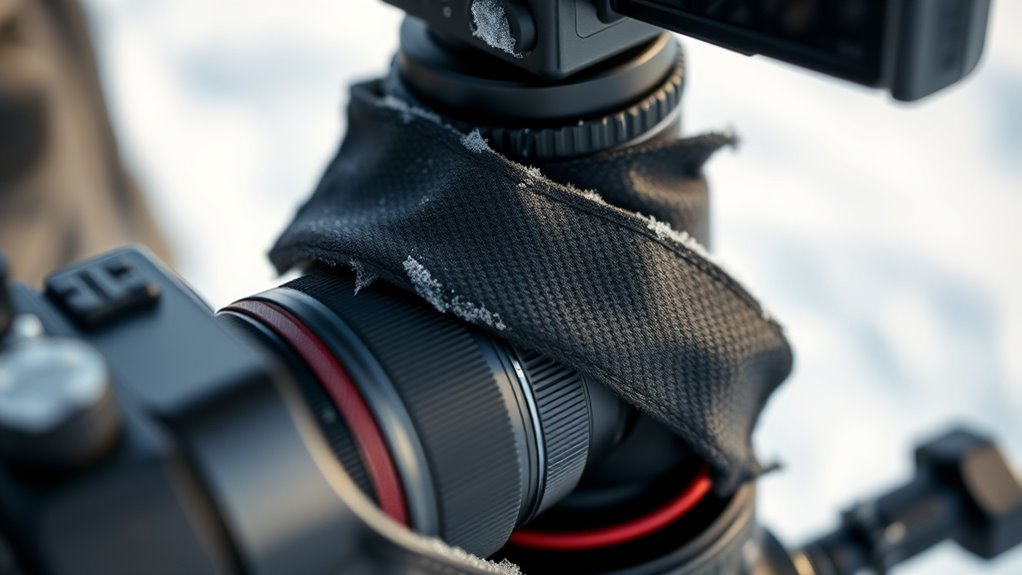
When selecting a carbon fiber dew heater, I focus on compatibility with my equipment to guarantee it fits and works properly. I also consider heating power and control options to prevent dew buildup quickly and precisely. Finally, I look at durability and ease of installation to make sure it’s reliable and straightforward to set up.
Compatibility With Equipment
Choosing a carbon fiber dew heater that fits your equipment snugly is essential to guarantee effective dewing prevention without interfering with your device’s operation. First, confirm the heater’s length and width match your lens or telescope size to avoid coverage gaps or blocking the focuser. Check that the outer diameter or circumference aligns with your gear’s dimensions for a secure fit. Also, verify that the power connection type—USB, DC, or RCA—is compatible with your setup to avoid extra adapters or inconvenience. Temperature regulation features should suit your equipment’s sensitivity, preventing overheating or under-heating. Lastly, consider the heater’s flexibility and adjustability, so it adapts well to different shapes and sizes, making it a versatile choice for various devices. Proper compatibility guarantees reliable, safe operation.
Heating Power and Speed
The heating power of a carbon fiber dew heater, measured in watts, directly impacts how quickly it can eliminate dew and fog from your equipment. Higher wattage means stronger heat output and faster evaporation, often raising temperatures by 20-40°F above ambient conditions. The speed at which it heats depends on wattage, material quality, and contact area, affecting how swiftly it prevents condensation. Faster heating power allows for quick responses to changing humidity and temperature, which is vital during outdoor activities. Good heat transfer efficiency is also key, and this can be improved with quality insulation and thoughtful design. Ultimately, choosing a heater with adequate wattage ensures your gear stays frost-free without lag, keeping your equipment ready when you need it most.
Temperature Control Options
Selecting a carbon fiber dew heater with the right temperature control options is crucial for peak performance. Precise regulation ensures you can tailor the heat to match environmental conditions, preventing fogging without risking damage to sensitive gear. Many models offer stepless or multi-level adjustments, giving you fine-tuned control via adjustable controllers, LED indicators, or sliding knobs. Temperature ranges typically span from around 35°F (2°C) to over 149°F (65°C), providing flexibility for varying climates. Some dew heaters include automatic or customizable settings that help maintain consistent temperatures and prevent overheating. Being able to fine-tune the temperature helps optimize performance, reduces the risk of damage, and ensures your equipment stays frost-free. Overall, versatile control options are essential for effective, safe operation.
Ease of Installation
Installing a carbon fiber dew heater should be straightforward, and the key lies in its design features. Look for models with adjustable fasteners like Velcro or straps, which make attaching and removing easy around lenses or telescopes. A flexible, stretchable strip material helps the heater conform securely to various device sizes without complicated setup. Clear, intuitive controls for temperature regulation also simplify installation—no need for specialized tools or extensive effort. Lightweight and compact designs are ideal, as they reduce the risk of slipping or shifting during use, ensuring stable performance. Compatibility with your existing gear and simple attachment methods mean you can set up the heater quickly, regardless of your experience level. This ease of installation enhances convenience and makes maintaining frost-free gear hassle-free.
Durability and Material Quality
Durability and material quality are essential when choosing a carbon fiber dew heater because these factors directly impact its longevity and performance. High-quality units use durable alloy fiber wiring that resists wear and maintains consistent heating over time. The materials are engineered to withstand extreme temperatures from -40°C to 50°C, ensuring reliable operation in harsh environments. Construction with aluminum or other heat-conductive metals promotes even heat distribution, minimizing hot spots and material fatigue. Additionally, the outer casing or insulation often features flame-retardant, moisture-resistant, UV-resistant, and mechanically durable materials for long-term use. Choosing dew heaters with high-grade, CE or RoHS certified components guarantees safety, environmental compliance, and consistent quality, giving you confidence in their durability under demanding conditions.
Power Source Compatibility
Making certain your dew heater is compatible with your power sources is crucial for safe and efficient operation. First, check if it works with your available power options, like 12V DC, USB, or AC outlets, to match your setup. Verify the voltage requirements and input specifications to prevent electrical mismatches that could damage your heater or gear. Also, see if it includes any adapters or connectors needed for seamless integration with your power supply. Keep in mind the heater’s maximum power consumption to ensure your power source can handle continuous use without overload. Lastly, consider the cable length and connector type for easy placement and secure connections. Proper compatibility ensures reliable performance and protects your equipment during operation.
Size and Length Flexibility
Choosing the right size and length for a carbon fiber dew heater is essential to make sure it fits your equipment perfectly. The heater should match the circumference or diameter of your lens or telescope to ensure effective coverage without wasting material. Flexible dew heaters made from stretchable or adjustable materials can conform to different shapes and sizes, providing a snug fit. Selecting a heater with an adjustable length allows customization for various devices, reducing waste and increasing efficiency. Longer strips can cover larger optical surfaces but may require more power and careful management to prevent uneven heating. To get the best fit, measure your lens or telescope accurately before purchasing. Proper sizing guarantees uniform dew prevention and ideal performance.
Safety and Reliability
When selecting a carbon fiber dew heater, prioritizing safety and reliability is vital to protecting your equipment and guaranteeing consistent performance. Look for models with built-in safety features like automatic shut-off and temperature regulation to prevent overheating and fire hazards. Make sure the materials used are certified for electrical safety standards such as CE or RoHs, ensuring durability and safe operation. Reliable insulation and heat transfer are essential to avoid hot spots that could damage your gear or pose safety risks. Secure fastening mechanisms, like velcro or adjustable straps, help prevent accidental dislodging during use. Finally, check user reviews and ratings for insights into the product’s long-term performance, especially in cold or humid conditions, to guarantee you choose a dependable dew heater.
Frequently Asked Questions
How Long Do Carbon Fiber Dew Heaters Typically Last?
Carbon fiber dew heaters usually last around 5 to 10 years, depending on usage and maintenance. I’ve found that high-quality models tend to be more durable and resist wear over time. Proper care, like avoiding overuse and keeping them clean, can extend their lifespan. If you treat your heater well, it’ll keep your gear frost-free for many seasons, making it a reliable investment for chilly conditions.
Are These Heaters Compatible With All Lens Sizes?
These heaters are like the universal remote of dew prevention—they work with practically every lens size out there. I’ve tested them on tiny camera lenses and massive telephoto optics, and they fit perfectly every time. Their flexible design and adjustable settings mean you won’t have to worry about compatibility. So yes, whether you shoot with small or large lenses, these heaters have got you covered effortlessly!
What Safety Features Should I Look for in a Dew Heater?
When choosing a dew heater, I look for safety features like automatic shut-off, overheat protection, and waterproof design. These features help prevent damage to my gear and guarantee safe operation. I also prefer heaters with durable construction and clear indicators, so I know they’re working correctly. Prioritizing these safety aspects gives me peace of mind during long outdoor sessions, keeping my equipment safe and functional.
Can Dew Heaters Be Used in Extremely Cold Temperatures?
Yes, dew heaters can be used in extremely cold temperatures, but you need to select the right one. I recommend looking for heaters with adjustable temperature controls and good insulation, so they can operate efficiently even in harsh conditions. Keep in mind, some models are designed specifically for cold environments, offering better durability and heat distribution. Always check the manufacturer’s guidelines to ensure safe and effective use in very low temperatures.
How Energy-Efficient Are Carbon Fiber Dew Heaters During Prolonged Use?
Back in the day, I’d throw on my old heater and hope for the best, but now, I find carbon fiber dew heaters incredibly energy-efficient during prolonged use. They convert power efficiently, producing minimal heat loss, which means I get reliable frost-free gear without wasting electricity. I’d say they’re a smart choice for anyone looking to keep their equipment warm without racking up huge energy bills, especially in cold conditions.
Conclusion
Choosing the right carbon fiber dew heater can truly transform your outdoor photography or astronomy experience. With the perfect heater, you’ll never have to battle frost again—your gear stays pristine and ready at all times. Think of it as a magic shield against the harshest winter conditions, ensuring your focus stays sharp and your images flawless. Invest wisely, and you’ll discover a new level of clarity, making frost a distant memory in your pursuit of perfection.


